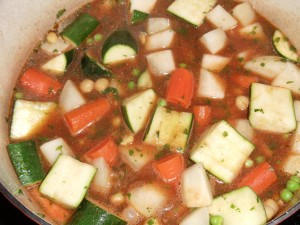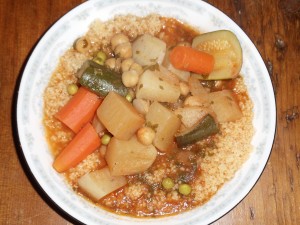Jan 30 2011
Moroccan Delight
“Of all the gin joints in all the towns in all the world, she walks into mine.” Rick certainly drowned his bitterness in a fair amount of gin in Casablanca. This fabulous Bogart movie, mostly set in the coastal Moroccan town of the same name during WWII, tells the story of Rick and the beautiful Ilsa (Ingrid Bergman), and their cork popping, torrid (well, as torrid as the Hollywood code would allow) love affair in Paris before the Nazis came and ruined everything, like they do.*
And so the champagne and the gin flow a-plenty in Rick’s Café Américain, but one character that is conspicuously absent from the set is food, other than the occasional caviar cameo. I’m quite sure that Rick, Ilsa and the gang must have subsided on more than just alcohol, fish eggs and fresh(ish) air. After all, the story takes place in France and Morocco, and neither place is wanting for culinary delights.
Which brings me to my father’s childhood friend, Jean-Claude. He was a captain in the French Merchant Navy, and he and his family were stationed in Morocco in the 60s. This is where his wife, Bernadette, learned how to make couscous. She shared her recipe with my mother, who would hereafter make it on Sundays, or for special occasions (such as my first communion lunch party). Those were times when people would sit around the table for hours, and eat, then digest and talk, then eat some more. That dish was luscious, made (as is more or less traditional) with chicken, lamb chops, merguez (spicy lamb sausages), and a variety of vegetables. My mother was a wonderful cook, and this was one of her signature dishes.
The word couscous itself describes the wheat granules that are the accompaniment to the meat and vegetable stew. It has, however, also come to name the dish. The right way of making the semoule, as it is referred to in French, is to steam it atop the stew in a special two-tiered pot called a couscoussier. Few Americans own one of these, and so the couscous that is sold in supermarkets has been pre-steamed and dried, and only needs a little boiling water to be reconstituted. Just ignore the instructions on the package that you buy; there’s a better and easier way of doing it.
Couscous marocain is really a very simple vegetable stew (with or without meat). What makes it stunning is the blend of spices that is used, called ras-el-hanout (راس الحانوت ). There is no single recipe for this blend. Traditionally, each store owner would have their own signature mix, that could contain anywhere from 10 to 100 different spices. French supermarkets carry a variety of blends, usually referred to as couscous spices, and many French cooks rely on those. I have some at home that I like to use, but it’s worth making your own. I am giving you a recipe (it packs a little heat — feel free to adjust the cayenne up or down, depending on your preferences) that will make enough to fill up a spice jar, so that you can have some on hand for a while. The list of ingredients is long, but I guarantee it’s worth it. It is amazingly fragrant and tasty. You will soon wonder how you ever managed without it.
2 teaspoons ground coriander
2 teaspoons ground cumin
2 teaspoons turmeric
2 teaspoons paprika
1.5 teaspoons ground ginger
1.5 teaspoons cinnamon
1 teaspoons ground black pepper
1 teaspoon cayenne pepper
1 teaspoon ground mustard seed
1 teaspoon cardamom powder
1 teaspoon garlic powder
½ teaspoon ground allspice
½ teaspoon ground nutmeg
½ teaspoon ground cloves
One last note on this Moroccan delight. While my mother used to make her couscous with a variety of meats, I (being a flexitarian and all) choose to make it entirely vegetarian these days, but I do not use peppers, which she sometimes did, because I’m not terribly fond of them here. Feel free to add meat if you like. I recommend browning some chicken legs and lamb chops before adding them to the vegetables. Increase cooking time to 35-40 mn, and be careful when stirring the stew, as you do no want to crush your vegetables. Any leftovers? Unlikely; but just in case, it tastes even better the next day.
*I obviously have a future as a movie critic. Anyone from the New York Times reading this?
Note on the harissa (a Northern African chili paste usually served alongside couscous): you can buy it here or make your own (recipe here).
1 lb turnips
2 medium zucchini
3 or 4 medium carrots
1 clove garlic, chopped
½ cup frozen peas
1 15oz can chickpeas
1 cup unseasoned tomato sauce
1 Tbsp ras el hanout
½ to 1 tsp harissa (optional – see note)
3 Tbsp chopped parsley
1 Tbsp chopped cilantro (optional)
2 cups water or broth
Salt to taste
1/3 cup dry couscous per person
Cut turnips in 1” cubes. Halve zucchinis and carrots and cut in 2” sections. Lightly sauté the vegetables in 2 tbsp peanut oil in a dutch oven over medium heat. When they are beginning to color, add the ras-el-hanout and garlic and sauté 1 min more, until the mixture becomes very fragrant. If using, mix harissa into tomato sauce along with the parsley and cilantro. Add this mix, along with the water or broth, to the vegetables. Add peas and chickpeas. Salt to taste, depending on whether you used water or broth, and how salty your broth is. Bring to a boil, reduce heat, cover and simmer until all the vegetables are tender, about 20mn. If you are concerned about the zucchini being overcooked, you can remove them after they have been sautéed and just reintroduce them into the stew 10mn before it’s done.
While the stew is cooking, prepare the couscous. Remember that steaming the couscous is always best, but in a pinch, this works too. Start by boiling water in your kettle. For each 1/3 cup of dry couscous you are using, mix 2 tsp melted butter or oil of your choice + a pinch of salt into the granules. Mix well until all grains are coated with fat. Place this mix in a large glass or ceramic bowl and cover with boiling water (the water should come to about ¼ to ½ inch above the couscous). Cover with a plate and let the couscous stand for 5 to 10 mn. Fluff with a fork before serving.
To serve, just bring the vegetable stew and the couscous in two separate bowls on the table. Dish out the couscous first, then cover with vegetables and broth.
Serve harissa on the side for those who, like Rick and Ilsa, like it hot.







I’m reading it; just wish there was something I could do
Sounds delish!
Thanks, Deb. Somehow, I don’t think it would pass muster anyway!
Thanks for the ras el hanout! A couscous will be in the making very soon in this house – I’ve even got the proper pot.
I know you do, Mary; enjoy!
Love the printable recipes thingy! Great addition!
Thanks! I think it makes it easier.
Christine, I’m going to a friend’s house tomorrow and am bringing an appetizer. Some there are vegan so I’d like to bring something really good in that space. Any suggestions?
Thanks!
Love as always,
Sheryl
Guacamole, baby! Since you live in avocado country, I think that’s the best. Need a recipe?